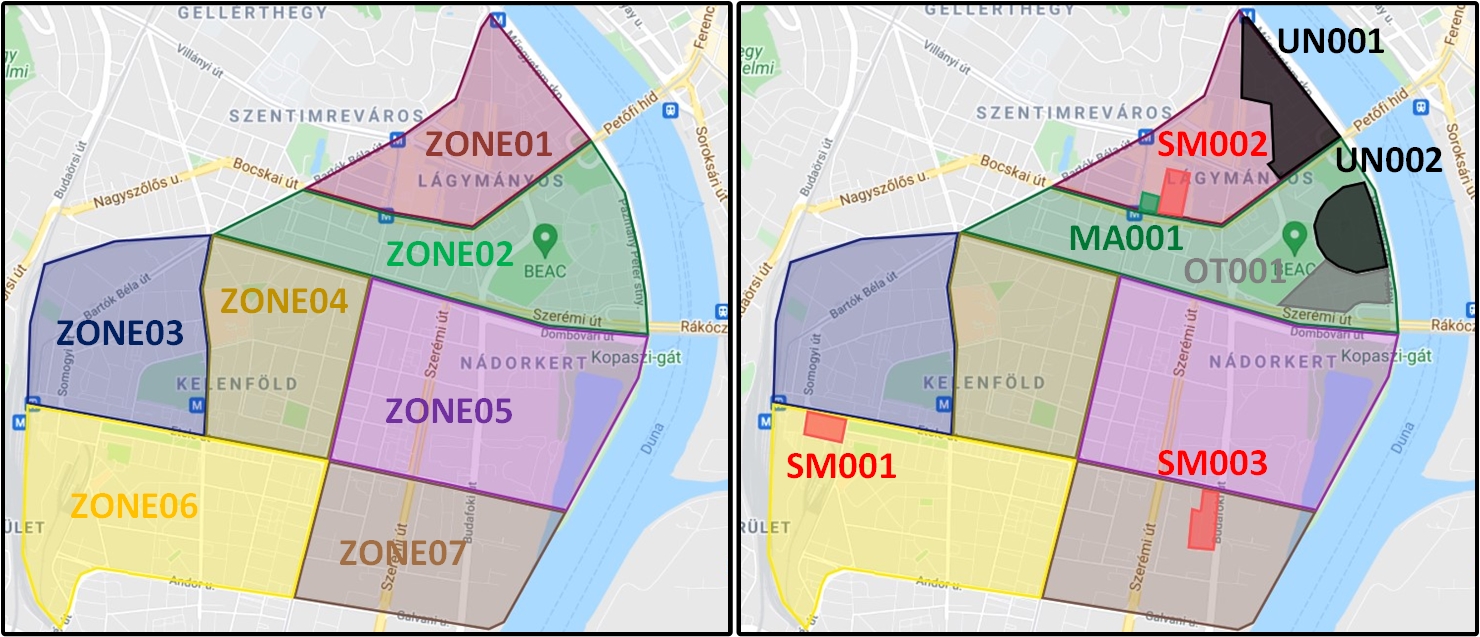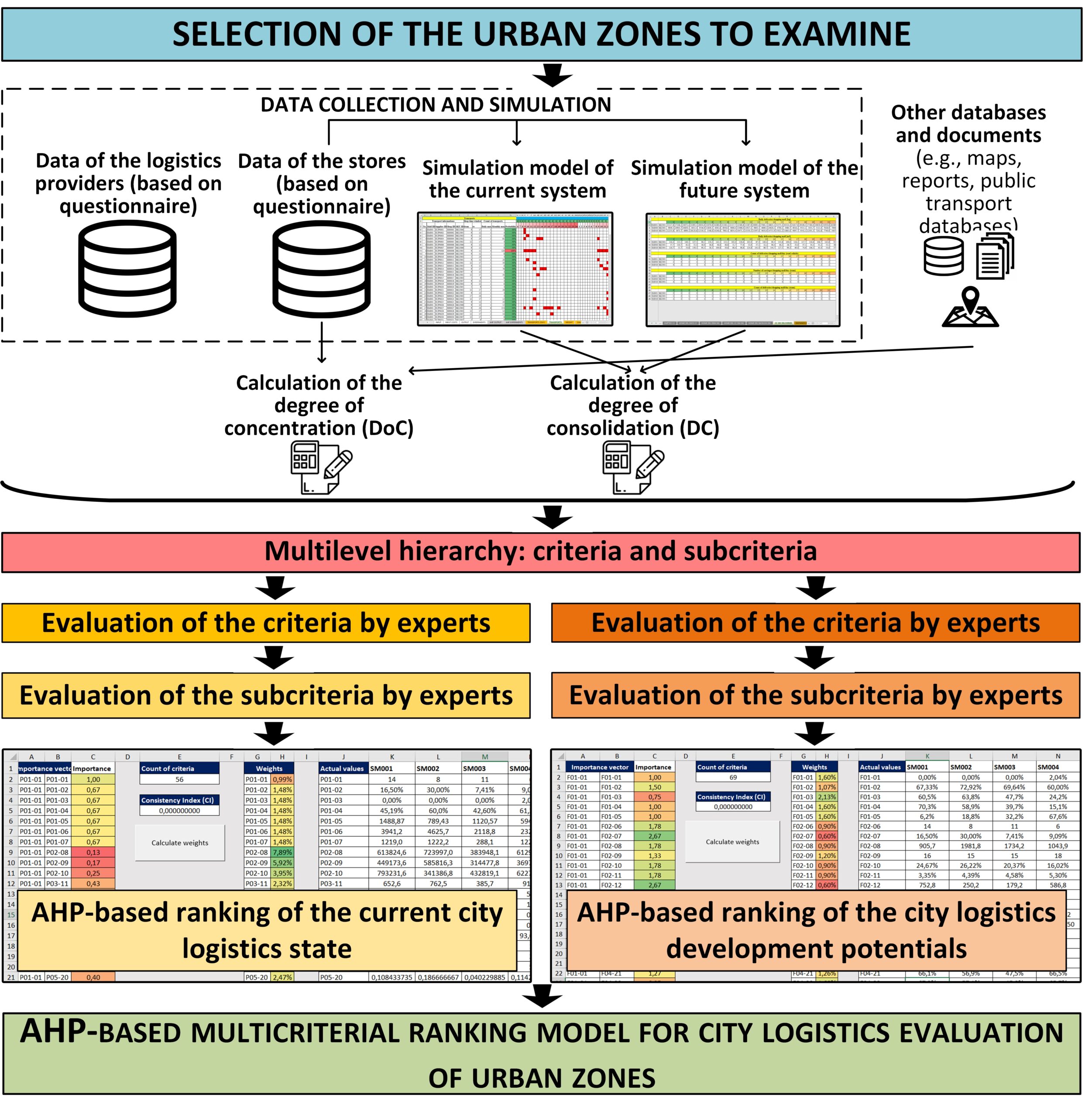Development of a multicriteria ranking model for the city logistics evaluation and analysis of urban areas
“SUPPORTED BY THE ÚNKP-19-3 NEW NATIONAL EXCELLENCE PROGRAM OF THE MINISTRY FOR INNOVATION AND TECHNOLOGY.”
“SUPPORTED BY THE ÚNKP-20-3 NEW NATIONAL EXCELLENCE PROGRAM OF THE MINISTRY FOR INNOVATION AND TECHNOLOGY FROM THE SOURCE OF THE NATIONAL RESEARCH, DEVELOPMENT AND INNOVATION FUND.”
Experts currently working on the project: Dávid Lajos Sárdi, Krisztián Bóna, Ph.D.
Start of the project: September 2019
Urban freight transport, due to its extraordinary impact on the sustainability of cities, is a major challenge nowadays. Within this, the problems with the logistics processes of the so-called concentrated sets of delivery locations, as they require many stores to be served in a small area. Based on our previous research, it seems that the development of a ranking model that could evaluate not only individual sets but also larger urban areas that include more than one concentrated set could be of great importance for the logistics development of the city.
In the research, we developed a multicriteria ranking system that can be used to evaluate not only certain concentrated sets of delivery locations but also larger urban areas and areas with separate delivery locations and concentrated sets of delivery locations in terms of the city logistics development. In this ranking model, we assessed the current city logistics solutions, the regulations, the restrictions, the share of the different transport modes (e.g., urban railways, cargo bikes), the occurrence of combined urban deliveries and gateway concept-based solutions, the development potentials, and all the aspects relevant for city logistics. In the project, first, we selected a suitable multicriteria ranking methodology (the Analytic Hierarchy Process/AHP method), which was adopted, and a suitable criteria system was used to get a real picture of the city logistics developments of each urban area and the development potentials of the areas were explored. Based on the results of this project, we can further assist future city logistics development projects by helping to identify areas where we could achieve the best results with city logistics developments.

Possible designation of urban zones for a multicriteria ranking on the example from Budapest (background: Google Maps)
The development of the ranking model was carried out in two phases. First, a one-level raking model was developed, and then a two-level hierarchy was built based on that.
During the first phase of our research project, the following tasks were completed:
-
- Selection of the appropriate multicriteria method (the AHP method) based on a detailed literature research
- Development of a criteria system for both the examination of the current city logistics state and the examination of the future city logistics development potential
- The weighting of each criterion with the involvement of experts from BME, Centre for Budapest Transport (BKK), and the Clean Air Action Group, determination of final weights based on 13 expert evaluations
- Formalization of the AHP-based multicriteria ranking model
- Collection of data required for testing the qualification model from the database of our previous questionnaire data collection as well as other public databases
- Development of our mesoscopic level simulation model, production of additional necessary data by simulation
- Filling the ranking model with data, testing the model on urban zones defined by three shopping malls
- Examining and incorporating new criteria that arise during the evaluation of the aspects into the qualification model
- Adding a fourth shopping mall to the mesoscopic level simulation model further development of the simulation model
- Filling the ranking model with the updated data, testing the model expanded with new criteria in the zone defined by four shopping malls
- Performing sensitivity analysis
- Designation of model development directions
In the second phase of model development during our project, we completed the following tasks:
-
- Adding new criteria in the qualification model based on the feedback received on publications and new research results, and new possible research directions
- Reorganization of the ranking criteria into a multi-level hierarchy
- Implementation of an algorithm for the optimal determination of weights within the AHP model
- The weighting of the new criteria with the involvement of experts from BME and the Clean Air Action Group, determination of final weights based on 18 expert evaluations
- Creation of a logistics service provider questionnaire to find out the data related to logistics service providers, sending the questionnaire to logistics service providers operating in Budapest, and processing the answers received
- Extension of the mesoscopic simulation model by examining the logistics processes of the Váci utca shopping area and a market from Budapest
- Filling the qualification model with the new data, testing the two-level model in the zone defined by seven concentrated sets of delivery locations in Budapest
- Testing of the completed ranking system
- Performing sensitivity analysis, identifying critical aspects
- Development of a tool for reading input data and performing the ranking automatically
- Testing and refining the completed device based on the test results

The process of applying the two-level multicriteria ranking model

The MS Excel-based ranking application
Significant documents related to the project
Dávid Lajos Sárdi, Krisztián Bóna, PhD. AHP-Based Multicriteria Ranking Model for the City Logistics Analysis of Urban Areas (2020).
10th International Conference on Logistics, Informatics and Service Sciences (LISS2020), Peking, online. Edited by Liu S., Bohács G., Shi X., Shang X., Huang A. Springer, Singapore. pp. 45-60.
URL: https://link.springer.com/chapter/10.1007%2F978-981-33-4359-7_4
ISBN: 978-981-334-358-0
DOI: 10.1007/978-981-33-4359-7_4
Krisztián Bóna, Dávid Lajos Sárdi. City Logistics Analysis of Urban Areas: An Analytic Hierarchy Process Based Study (2021).
Journal of System and Management Sciences, 11 (2), pp. 77-105.
URL: http://www.aasmr.org/jsms/Vol11/vol.11.2.6.pdf
DOI: 10.33168/JSMS.2021.0206
ISSN 1816-6075